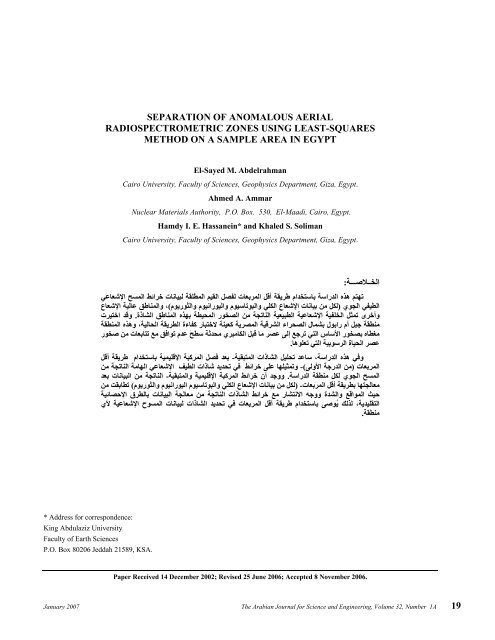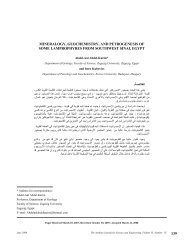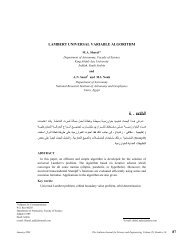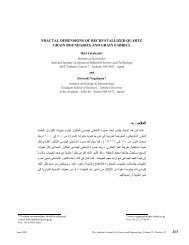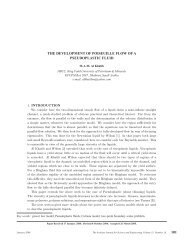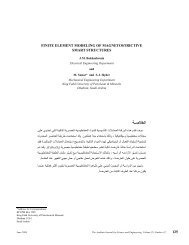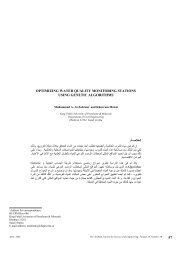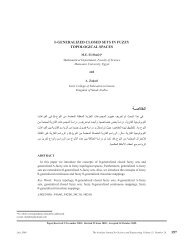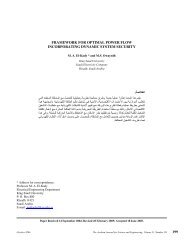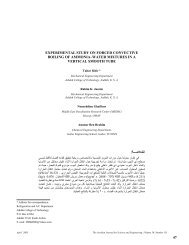19 separation of anomalous aerial radiospectrometric zones using ...
19 separation of anomalous aerial radiospectrometric zones using ...
19 separation of anomalous aerial radiospectrometric zones using ...
Create successful ePaper yourself
Turn your PDF publications into a flip-book with our unique Google optimized e-Paper software.
* Address for correspondence:<br />
King Abdulaziz University<br />
Faculty <strong>of</strong> Earth Sciences<br />
P.O. Box 80206 Jeddah 21589, KSA.<br />
El-Sayed M. Abdelrahman, Ahmed A. Ammar, Hamdy I. E. Hassanein and Khaled S. Soliman<br />
SEPARATION OF ANOMALOUS AERIAL<br />
RADIOSPECTROMETRIC ZONES USING LEAST-SQUARES<br />
METHOD ON A SAMPLE AREA IN EGYPT<br />
El-Sayed M. Abdelrahman<br />
Cairo University, Faculty <strong>of</strong> Sciences, Geophysics Department, Giza, Egypt.<br />
Ahmed A. Ammar<br />
Nuclear Materials Authority, P.O. Box. 530, El-Maadi, Cairo, Egypt.<br />
Hamdy I. E. Hassanein* and Khaled S. Soliman<br />
Cairo University, Faculty <strong>of</strong> Sciences, Geophysics Department, Giza, Egypt.<br />
: ﺔـــﺻﻼــﺨﻟا<br />
ﻲﻋﺎﻌﺷﻹا ﺢﺴﻤﻟا ﻂﺋاﺮﺧ تﺎﻧﺎﻴﺒﻟ ﺔﻘﻠﻄﻤﻟا ﻢﻴﻘﻟا ﻞﺼﻔﻟ تﺎﻌﺑﺮﻤﻟا ﻞﻗأ ﺔﻘﻳﺮﻃ ماﺪﺨﺘﺳﺎﺑ ﺔﺳارﺪﻟا ﻩﺬه ﻢﺘﻬﺗ<br />
عﺎﻌﺷﻹا ﺔﻴﻟﺎﻋ ﻖﻃﺎﻨﻤﻟاو<br />
،(<br />
مﻮﻳرﻮﺜﻟاو مﻮﻴﻧارﻮﻴﻟاو مﻮﻴﺳﺎﺗﻮﺒﻟاو ﻲﻠﻜﻟا عﺎﻌﺷﻹا تﺎﻧﺎﻴﺑ ﻦﻣ ﻞﻜﻟ)<br />
يﻮﺠﻟا ﻲﻔﻴﻄﻟا<br />
تﺮﻴﺘﺧا ﺪﻗو . ةذﺎﺸﻟا ﻖﻃﺎﻨﻤﻟا ﻩﺬﻬﺑ ﺔﻄﻴﺤﻤﻟا رﻮﺨﺼﻟا ﻦﻣ ﺔﺠﺗﺎﻨﻟا ﺔﻴﻌﻴﺒﻄﻟا ﺔﻴﻋﺎﻌﺷﻹا ﺔﻴﻔﻠﺨﻟا ﻞﺜﻤﺗ ىﺮﺧأو<br />
ﺔﻘﻄﻨﻤﻟا ﻩﺬهو<br />
،ﺔﻴﻟﺎﺤﻟا ﺔﻘﻳﺮﻄﻟا ةءﺎﻔآ رﺎﺒﺘﺧﻻ ﺔﻨﻴﻌآ ﺔﻳﺮﺼﻤﻟا ﺔﻴﻗﺮﺸﻟا ءاﺮﺤﺼﻟا لﺎﻤﺸﺑ لﻮﺑار مأ ﻞﺒﺟ ﺔﻘﻄﻨﻣ<br />
رﻮﺨﺻ ﻦﻣ تﺎﻌﺑﺎﺘﺗ ﻊﻣ ٍﻖﻓاﻮﺗ ِمﺪﻋ َﺢﻄﺳ ﺔﺛﺪﺤﻣ يﺮﺒﻣﺎﻜﻟا ﻞﺒﻗ ﺎﻣ ﺮﺼﻋ ﻰﻟإ ﻊﺟﺮﺗ ﻲﺘﻟا سﺎﺳﻷا رﻮﺨﺼﺑ ﻩﺎﻄﻐﻣ<br />
. ﺎهﻮﻠﻌﺗ ﻲﺘﻟا ﺔﻴﺑﻮﺳﺮﻟا<br />
ةﺎﻴﺤﻟا ﺮﺼﻋ<br />
ﻞﻗأ ﺔﻘﻳﺮﻃ ماﺪﺨﺘﺳﺎﺑ ﺔﻴﻤﻴﻠﻗﻹا ﺔﺒآﺮﻤﻟا ﻞﺼﻓ ﺪﻌﺑ -ﺔﻴﻘﺒﺘﻤﻟا<br />
تاذﺎﺸﻟا ﻞﻴﻠﺤﺗ ﺪﻋﺎﺳ ،ﺔﺳارﺪﻟا ﻩﺬه ﻲﻓو<br />
ﻦﻣ ﺔﺠﺗﺎﻨﻟا ﺔﻣﺎﻬﻟا ﻲﻋﺎﻌﺷﻹا ﻒﻴﻄﻟا تاذﺎﺷ ﺪﻳﺪﺤﺗ ﻲﻓ ﻂﺋاﺮﺧ ﻰﻠﻋ ﺎﻬﻠﻴﺜﻤﺗو -(<br />
ﻰﻟوﻷا ﺔﺟرﺪﻟا ﻦﻣ)<br />
تﺎﻌﺑﺮﻤﻟا<br />
ﺪﻌﺑ تﺎﻧﺎﻴﺒﻟا ﻦﻣ ﺔﺠﺗﺎﻨﻟا -ﺔﻴﻘﺒﺘﻤﻟاو<br />
ﺔﻴﻤﻴﻠﻗﻹا ﺔﺒآﺮﻤﻟا<br />
ﻂﺋاﺮﺧ نأ ﺪﺟوو . ﺔﺳارﺪﻟا ﺔﻘﻄﻨﻣ ﻞﻜﻟ يﻮﺠﻟا ﺢﺴﻤﻟا<br />
ﻦﻣ ﺖﻘﺑﺎﻄﺗ ( مﻮﻳرﻮﺜﻟاو مﻮﻴﻧارﻮﻴﻟا مﻮﻴﺳﺎﺗﻮﺒﻟاو ﻲﻠﻜﻟا عﺎﻌﺷﻹا تﺎﻧﺎﻴﺑ ﻦﻣ ﻞﻜﻟ)<br />
-تﺎﻌﺑﺮﻤﻟا<br />
ﻞﻗأ ﺔﻘﻳﺮﻄﺑ ﺎﻬﺘﺠﻟﺎﻌﻣ<br />
ﺔﻴﺋﺎﺼﺣﻹا قﺮﻄﻟﺎﺑ تﺎﻧﺎﻴﺒﻟا ﺔﺠﻟﺎﻌﻣ ﻦﻣ ﺔﺠﺗﺎﻨﻟا تاذﺎﺸﻟا ﻂﺋاﺮﺧ ﻊﻣ رﺎﺸﺘﻧﻻا ﻪﺟوو ةﺪﺸﻟاو ﻊﻗاﻮﻤﻟا ﺚﻴﺣ<br />
يﻷ ﺔﻴﻋﺎﻌﺷﻹا حﻮﺴﻤﻟا تﺎﻧﺎﻴﺒﻟ تاذﺎﺸﻟا ﺪﻳﺪﺤﺗ ﻲﻓ تﺎﻌﺑﺮﻤﻟا ﻞﻗأ ﺔﻘﻳﺮﻃ ماﺪﺨﺘﺳﺎﺑ ﻰﺻﻮُﻳ ﻚﻟﺬﻟ ،ﺔﻳﺪﻴﻠﻘﺘﻟا<br />
. ﺔﻘﻄﻨﻣ<br />
Paper Received 14 December 2002; Revised 25 June 2006; Accepted 8 November 2006.<br />
January 2007 The Arabian Journal for Science and Engineering, Volume 32, Number 1A <strong>19</strong>
El-Sayed M. Abdelrahman, Ahmed A. Ammar, Hamdy I. E. Hassanein and Khaled S. Soliman<br />
ABSTRACT<br />
This study deals with <strong>using</strong> the least-squares method (LSM) to separate the<br />
absolute aero<strong>radiospectrometric</strong> maps (T.C., 40 K, eU, and eTh) into highly<br />
radioactive <strong>zones</strong> and the normal radioactive background <strong>of</strong> the host rocks. The<br />
Gabal Um-Rabul area, selected for testing the efficiency <strong>of</strong> the present method,<br />
lies in the northern part <strong>of</strong> the Eastern Desert <strong>of</strong> Egypt and is covered mainly by<br />
Precambrian basement rocks, which are unconformably overlain by Phanerozoic<br />
sedimentary successions.<br />
In the present study, the least-squares (first-order) residual anomaly analysis<br />
method was used and contour maps were drawn to delineate the significant<br />
aero<strong>radiospectrometric</strong> anomalies over the study area. It was found that, the<br />
least-squares first-order regional and residual total-count (T.C.) and the three<br />
absolute radioelements (K, eU, & eTh) maps <strong>of</strong> the study area show a high<br />
degree <strong>of</strong> coincidence with the <strong>anomalous</strong> maps constructed by the conventional<br />
statistical methods in terms <strong>of</strong> the locations, intensities, and trends <strong>of</strong> <strong>anomalous</strong><br />
<strong>zones</strong>. Therefore, it is recommended to apply the least squares method for<br />
locating radioelements <strong>anomalous</strong> <strong>zones</strong> in any surveyed area.<br />
Key words: Least-Square Method (LSM), Aeroradiospectrometry, Gabal Um<br />
Rabul, Geological setting, Normal probability plot, Regional residual <strong>separation</strong>,<br />
Northern Eastern Desert <strong>of</strong> Egypt.<br />
20 The Arabian Journal for Science and Engineering, Volume 32, Number 1A January 2007
El-Sayed M. Abdelrahman, Ahmed A. Ammar, Hamdy I. E. Hassanein and Khaled S. Soliman<br />
SEPARATION OF ANOMALOUS AERIAL RADIOSPECTROMETRIC ZONES USING<br />
LEAST-SQUARES METHOD ON A SAMPLE AREA IN EGYPT<br />
INTRODUCTION<br />
The major objectives <strong>of</strong> <strong>aerial</strong> gamma-ray spectrometer data interpretation are the identification <strong>of</strong> <strong>anomalous</strong><br />
measurements and outlining the probable boundaries <strong>of</strong> potential uraniferous provinces, in which the rocks and soils are<br />
preferentially enriched in uranium [1]. There are several different ways to identify and outline potential uraniferous<br />
provinces through the examination <strong>of</strong> the two- and three-radioelement ratios and standard deviation anomaly maps. The<br />
present study is a first trial to use the least square method (LSM) to identfy potential relative <strong>anomalous</strong> <strong>zones</strong>.<br />
Since mid-<strong>19</strong>67 high sensitive, quantitative airborne gamma-ray spectrometry has been applied extensively in<br />
support <strong>of</strong> geological mapping and mineral exploration, especially in regions where the geology is more complex and<br />
access is difficult. The method depends upon the fact that the measured absolute and relative concentrations <strong>of</strong> the<br />
radioelements K, U, and Th vary significantly with lithology [2].<br />
The Gabal Um-Rabul study area is located in the northern part <strong>of</strong> the Eastern Desert <strong>of</strong> Egypt, to the west <strong>of</strong> Ras<br />
Gharib town on the western coast <strong>of</strong> the Gulf <strong>of</strong> Suez, and is bounded by latitudes 28° 07′ 30′′ N and 28° 27′ 30′′ N and<br />
longitudes 32° 20′ E and 32° 50′ E (Figure 1). The area is mainly covered by Precambrian igneous and metamorphic<br />
rocks, which constitute a part <strong>of</strong> the Arabian–Nubian Shield (Figure 2a). To the west, basement rocks are unconformably<br />
overlain by Phanerozoic sedimentary succession. The general topography <strong>of</strong> the eastern part <strong>of</strong> the study area is more<br />
rugged than its western part. In addition, the examined area includes a part <strong>of</strong> the Red Sea plain in the east. The study<br />
area is generally dissected by several NE, ENE, NW, and E-W trending wadis (dry drainage), which are mainly<br />
structurally controlled.<br />
Based on analyses and interpretation <strong>of</strong> aero<strong>radiospectrometric</strong> survey data <strong>using</strong> conventional statistical methods,<br />
the interpreted radiometric–lithologic units (IRLU) map (Figure 2b) shows that, the study area comprises four basement<br />
rock units: Metavolcanics (11.9 Ur, and 1.9 % 40 K, 2.3 ppm eU, and 7.3 ppm eTh) , Older granites (9.95 U, 1.4 % 40 K,<br />
2.2 ppm eU, and 6.1 ppm eTh), Dokhan volcanics (5.1 U, 0.5 % 40 K, 1.5 ppm eU, and 3.6 ppm eTh), and Younger<br />
granites ( 12.6 Ur, 2.0 % 40 K, 2.4 ppm eU, and 7.4 ppm eTh). Also, the area includes five sedimentary units: Araba<br />
Formation ( 4.3 U, 0.4 % 40 K, 1.3 ppm, eU and 3.3 ppm eTh), Samr El-Qaa Formation (4.0 Ur, 0.4 % 40 K, 1.3 ppm eU<br />
& 3.0 ppm eTh), Wadi Qena Formation (3.95 U, 0.4 % 40 K, 1.5 ppm eU & 2.7 ppm eTh), Galala Formation (4.1 U,<br />
0.46 % 40 K, 1.35 ppm eU and 2.8 ppm eTh), and the Quaternary sediments (10.6 U, 1.7 % 40 K, 2.3 ppm eU, and 6.0<br />
ppm eTh)[3].<br />
32N 25 E 27 29 31<br />
Mediterranian Sea<br />
Alexandria<br />
33 35 37<br />
32<br />
30<br />
28<br />
26<br />
24<br />
Libya<br />
Qattara Depession<br />
Siwa Oasis<br />
Cairo<br />
Study<br />
Area<br />
Suez<br />
Sinai<br />
Western Desert<br />
Dakhla Oasis<br />
kharga Oasis<br />
Eastern<br />
Desert<br />
Nasser Lake<br />
Ras Gharib<br />
0 100 200 km<br />
22<br />
25 27<br />
Sudan<br />
29 31 33 35 37<br />
January 2007 The Arabian Journal for Science and Engineering, Volume 32, Number 1A 21<br />
Qena<br />
Aswan<br />
Red<br />
Figure 1. Map <strong>of</strong> Egypt showing the location <strong>of</strong> Gabal Um Rabul<br />
area in the northern part <strong>of</strong> the Eastern Desert.<br />
Sea<br />
30<br />
28<br />
26<br />
24<br />
22
El-Sayed M. Abdelrahman, Ahmed A. Ammar, Hamdy I. E. Hassanein and Khaled S. Soliman<br />
32 20 00E 32 50 00<br />
28 27 30 N<br />
28 27 30<br />
LEGEND<br />
Quaternary<br />
Sediments<br />
W. Ghazala<br />
Galala<br />
Formation<br />
N<br />
Wadi Qena<br />
Formation<br />
Samr El-Qaa<br />
Formation<br />
G. Um Rabul<br />
Araba<br />
Formation<br />
Younger<br />
GB<br />
Granites<br />
VD Dokhan<br />
Volcanics<br />
Older<br />
Granites<br />
28 07 30<br />
32 20 00<br />
G. Samr El-Abd<br />
0 2 4 6 8 km<br />
28 07 30<br />
32 50 00<br />
Figure 2 (a). Geological map <strong>of</strong> Gabal Um Rabul area [4].<br />
32 20 00E 32 50 00<br />
28 27 30 N<br />
28 27 30<br />
N<br />
28 07 30<br />
32 20 00<br />
pz<br />
G. Samr El-Qaa<br />
W. Ghazala<br />
W. Hawashiya<br />
G. Umm Rabul<br />
G. Samr El-Abd<br />
0 2 4 6<br />
28 07 30<br />
32 50 00<br />
8 km<br />
Metavolcanics<br />
W. Wadi<br />
(Dry Valley)<br />
G. Gabal<br />
(Mountain)<br />
LEGEND<br />
Quaternary-4<br />
Sediments<br />
Quaternary-3<br />
Sediments<br />
Quaternary-2<br />
Sediments<br />
Quaternary-1<br />
Sediments<br />
Galala<br />
Formation-2<br />
Galala<br />
Formation-1<br />
Wadi Qena<br />
Formation-2<br />
Wadi Qena<br />
Formation-1<br />
Samr El-Qaa<br />
Formation<br />
Araba<br />
Formation<br />
Younger<br />
Granites-1<br />
Dokhan<br />
Volcanics-2<br />
Dokhan<br />
Volcanics-1<br />
22 The Arabian Journal for Science and Engineering, Volume 32, Number 1A January 2007<br />
GB-3<br />
GB-2<br />
GB-1<br />
VD-2<br />
VD-1<br />
Younger<br />
Granites-3<br />
Younger<br />
Granites-2<br />
Older<br />
Granites-4<br />
Older<br />
Granites-3<br />
Older<br />
Granites-2<br />
Older<br />
Granites-1C<br />
Older<br />
Granites-1B<br />
Older<br />
Granites-1A<br />
Weathered<br />
Older Granites-2<br />
Weathered<br />
Older Granites-1<br />
Metavolcanics-3<br />
Metavolcanics-2<br />
Metavolcanics-1<br />
Prospective<br />
pz Zone<br />
W.<br />
Wadi (Dry Valley)<br />
G. Gabal (Mountain)<br />
Figure 2 (b). Interpreted radiometric–lithologic units (IRLU) map <strong>of</strong> Gabal Um Rabul area.<br />
In the present study, the least-squares method was applied on the total-count (T.C.) survey data <strong>of</strong> the<br />
aeroradiometry, aero<strong>radiospectrometric</strong> potassium ( 40 K%), equivalent uranium (eU), and equivalent thorium (eTh). The<br />
application <strong>of</strong> least-squares residuals technique in aero<strong>radiospectrometric</strong> data may be <strong>of</strong> interest especially in the field<br />
<strong>of</strong> <strong>aerial</strong> <strong>radiospectrometric</strong> exploration. T.C., 40 K%, eU, and eTh maps were subjected to a <strong>separation</strong> technique <strong>using</strong><br />
the least-squares method to separate the highly radioactive <strong>zones</strong> from the normal radioactive background <strong>of</strong> the host<br />
rocks. Regional components <strong>of</strong> the first, second, third, fourth, and fifth orders were fitted to the input data. Correlation<br />
coefficients between successive residual maps were computed in order to determine the optimum order <strong>of</strong> the regional<br />
surface to be used. The regional field in this particular area can be represented as first-order, because the first order gave<br />
a good correlation factor in each case.<br />
The least-squares method (LSM) was used to construct the first-order regional and residual total-count (T.C.) and<br />
the three absolute radioelements (K, eU, & eTh) maps <strong>of</strong> the study area. The produced residual <strong>radiospectrometric</strong> maps<br />
were compared with the point (local) anomaly maps, produced by the conventional statistical methods. The present study<br />
delineates some locations <strong>of</strong> high and very high <strong>aerial</strong> <strong>radiospectrometric</strong> levels which identify and outline<br />
aero<strong>radiospectrometric</strong> significant anomalies all over the study area .<br />
GEOLOGICAL SETTING<br />
The rocks exposed in Gabal Um-Rabul area can be grouped according to their mode <strong>of</strong> occurrence and their mutual<br />
relationships from top to bottom as the following sequence (Figure 2a) [4].
El-Sayed M. Abdelrahman, Ahmed A. Ammar, Hamdy I. E. Hassanein and Khaled S. Soliman<br />
Phanerozoic Rocks<br />
The Phanerozoic sedimentary rocks which are represented in the western part <strong>of</strong> the area under investigation, are<br />
descried briefly in the following paragraphs.<br />
Quaternary Sediments (Quaternary – QW)<br />
According to the geological map (Figure 2a) <strong>of</strong> the study area, the undifferentiated Quaternary Sediments (QW) are<br />
situated in four localities. The average T.C. radioactivity <strong>of</strong> Quaternary sediments is 10.6 U [3]. They are classified into<br />
four interpreted radiolithologic units (IRLU) QW-1, QW-2, QW-3 and QW-4 as seen in Figure 2b. Quaternary deposits<br />
consist mainly <strong>of</strong> wadi aluvium deposits which is composed <strong>of</strong> loose rock fragments from the surrounding rocks.<br />
Galala Formation (Cenomanian–Early Turonian – KUG)<br />
According to (Figure 2a), the Galala Formation (KUG) is exposed in the western part <strong>of</strong> the the study area in two<br />
localities and is mainly composed <strong>of</strong> limestone, some dark browin grey sandstone, and clay bands intercalations. As a<br />
result <strong>of</strong> the application <strong>of</strong> the conventional statistical methods <strong>of</strong> analysis, Galala Formation was treated as two<br />
independent IRLU (KUG-1 and KUG-2) (Figure 2b). The average T. C. radioactivity <strong>of</strong> Galala Formation is 4.1 Ur,<br />
[3].<br />
Wadi Qena Formation (Early Cretaceous – KLQ)<br />
The Wadi Qena Formation (KLQ) is located in three localities in the western part <strong>of</strong> the study area (Figure 2a). This<br />
formation is composed <strong>of</strong> sandstones which was deposited during Albian Cenomanian age. The application <strong>of</strong> the<br />
convensional statistical analysis prove that the Wadi Qena Formation was involved in two IRLU (KLQ-1 & KLQ-2,<br />
Figure 2b). The average T. C, radiactivity <strong>of</strong> the Wadi Qena formation is 3.95 Ur.<br />
Samr El-Qaa Formation (Carboniferous – CQ)<br />
The Samr El-Qaa (CQ) Formation is exposed in only one locality within the study area (Figure 2a). It is mainly<br />
composed <strong>of</strong> Carboniferous age shale deposites. This formation yielded a T.C. average value <strong>of</strong> 4.0 U.<br />
Araba Formation (Cambrian – ES)<br />
The Araba Formation (ES) is exposed in two localities: one locality in the northwestern part and the other in the<br />
southwestern part <strong>of</strong> the study area. This unit is mainly composed <strong>of</strong> sandstones <strong>of</strong> Cambrian age. The previous<br />
statistical analysis <strong>of</strong> the aeroradiometric data indicated that the Araba Formation in both localities represent a single<br />
IRLU. The average value <strong>of</strong> T.C. <strong>of</strong> this IRLU is 4.3 U.<br />
Precambrian Basement Rocks<br />
Younger Granites (GB)<br />
In the present study area uounger (pink) granites (GB) are represented by the calc- alkaline members [6]. Their<br />
composition ranges from monzogranite to ideal granite. This type <strong>of</strong> granites are more resistant to weathering and<br />
occupy terrains <strong>of</strong> higher relief than the older granite (GA). Three (IRLUs (GB-1, GB-2, and GB-3) have been in this<br />
rock unit (Figure 2b)<br />
Dokhan Volcanics<br />
Typical sequences <strong>of</strong> this rock unit are composed <strong>of</strong> intermediate to acidic volcanic rocks with their pyroclastic<br />
equivalents. They are divided, petrographically, into andesite, quartz andesite, dacite, ryholite, quartz trachyte, and<br />
pyroclastics [7]. Typical outcrops <strong>of</strong> the Dokhan volcanics are seen at Gabal Samr El-Qaa and two other occurrences are<br />
located in the southwestern part <strong>of</strong> the basement complex outcrop in the study area. Dokan volcanics comprise two<br />
IRLUs (VD-1 and VD-2) as seen in Figure 2b.<br />
Older granites (GA)<br />
Older granites (GA) are grey synorogenic and range in composition from quartz diorites to granodiorites and locally<br />
monzonites [6]. Commonly, this type <strong>of</strong> granite occurs in the form <strong>of</strong> elongated large bodies parallel to the NW–SE<br />
regional structural trend. GA-granite is easily susceptible to weathering, and occupies low-lying terrains strewn with<br />
small hillocks and traversed by wide sandy wadis. Weathered older granites (GAW) are mapped separately in Figure 2a.<br />
The application <strong>of</strong> the conventional statistical methods <strong>of</strong> analysis [8] differentiated the older granites in the present<br />
area into eight subunits (GAW-1, GAW-2, GA-1A, GA-1B, GA-1C, GA-2, GA-3, GA-4). as shown in Figure 2b.<br />
January 2007 The Arabian Journal for Science and Engineering, Volume 32, Number 1A 23
El-Sayed M. Abdelrahman, Ahmed A. Ammar, Hamdy I. E. Hassanein and Khaled S. Soliman<br />
Metavolcanics<br />
These rocks are interpreted as the products <strong>of</strong> volcanic activity during eugeosyncline subsidental phase [8]. The<br />
metavolcanics in the Eastern Desert are generally subdivided into three classes:<br />
1. Intermediate to acidic metavolcanics and metapyroclastics.<br />
2. Ophiolitic metavolcanics.<br />
3. Metavolcanics, undifferentiated.<br />
Ophiolitic metavolcanics and undifferentiated metavolcanics, are not represented in the study area. Metavolcanics in<br />
the study area belong to the intermediate to acidic metavolcanic and metapyroclastics (MVA) class. Typical outcrops are<br />
seen around Gabal Samr El-Abd (Figure 2a). They are intimately associated with sediments [6] that are largely<br />
composed <strong>of</strong> tuffs and volcanogenic greywackes. The intermediate to acidic metavolcanic and metapyroclastics are<br />
essentially composed <strong>of</strong> meta-andesites and metadacites together with subordinate amounts <strong>of</strong> metabasalts and<br />
metarhyolites. According to the radiometric survey, this unit is divided into three subunits (MVA-1, MVA-2 & MVA-<br />
3), in Figure 2b.<br />
AERORADIOSPECTROMETRIC SURVEY AND DATA PRESENTATION<br />
In <strong>19</strong>84 Western Geophysical Company <strong>of</strong> America carried out aeroradio spectrometric and aeromagnetic surveys<br />
for most <strong>of</strong> the surface area <strong>of</strong> the Eastern Desert <strong>of</strong> Egypt under a joint venture <strong>of</strong> the Egyptian General Petroleum<br />
Corporation (EGPC) and the Egyptian Geological Survey and Mining Authority (EGSMA).<br />
The aero<strong>radiospectrometric</strong> survey was conducted along parallel flight lines oriented in a NE–SW direction at 1.5<br />
km spacing. A high-sensitivity 256-channel airborne gamma-ray spectrometer (AGRS) system was used for gamma-ray<br />
measurements. For safety reasons, the flight altitude was 92m in flat terrains and 122m in mountainous terrains [10]. The<br />
data were corrected and plotted as aero<strong>radiospectrometric</strong> contour maps and pr<strong>of</strong>iles. In the present study, the digitizing<br />
process follows the basic acquired analog pr<strong>of</strong>iles <strong>of</strong> the flight lines drawn on the map and color image techniques were<br />
used in the interpretation <strong>of</strong> <strong>aerial</strong> gamma ray spectrometric data [11].<br />
Consequently, the digitized total-count radiometry in Ur (radioactivity <strong>of</strong> 1 ppm <strong>of</strong> uranium), potassium in<br />
percentage, equivalent uranium & equivalent thorium contents in ppm, were plotted in the form <strong>of</strong> filled-color image<br />
maps (Figures 3– 6).<br />
The colored image maps, which are generated by assigning different colors to each grid element based on some<br />
attribute such as intensity, are more adequate for the human visual system interpretation <strong>of</strong> images than line drawings.<br />
Displaying geophysical data in color image form can <strong>of</strong>ten reveal information that is hidden in contour or pr<strong>of</strong>ile maps<br />
[11–14]. Type and number <strong>of</strong> the used colors are determined according to the numerical range <strong>of</strong> the data. It is better to<br />
use a set <strong>of</strong> standard colors to avoid confusion when interpreting numerous images [15].<br />
32 20 00E 32 50 00<br />
28 27 30 N<br />
28 27 30<br />
N<br />
28 07 30<br />
32 20 00<br />
0 2 4 6 8km<br />
28 07 30<br />
32 50 00<br />
24 The Arabian Journal for Science and Engineering, Volume 32, Number 1A January 2007<br />
L5<br />
L4<br />
L3<br />
L2<br />
L1<br />
32<br />
30<br />
28<br />
26<br />
24<br />
22<br />
20<br />
18<br />
16<br />
14<br />
12<br />
10<br />
8<br />
6<br />
4<br />
T. C. in Ur<br />
Figure 3. Filled-contour image map <strong>of</strong> the <strong>aerial</strong> total-count aero radiometric data.
32 20 00E<br />
28 27 30 N<br />
N<br />
28 07 30<br />
32 20 00<br />
El-Sayed M. Abdelrahman, Ahmed A. Ammar, Hamdy I. E. Hassanein and Khaled S. Soliman<br />
0 2 4 6 8<br />
Figure 4. Filled-contoured image anomaly map <strong>of</strong> the aero radio spectrometric potassium.<br />
32 50 00<br />
28 27 30<br />
32 50 00<br />
28 07 30<br />
January 2007 The Arabian Journal for Science and Engineering, Volume 32, Number 1A 25<br />
km<br />
(0.1 %)<br />
L5<br />
L4<br />
L3<br />
L2<br />
L1<br />
32<br />
30<br />
28<br />
26<br />
24<br />
22<br />
20<br />
18<br />
16<br />
14<br />
12<br />
10<br />
8<br />
6<br />
4<br />
2<br />
K 0.1 %<br />
32 20 00E 32 50 00<br />
28 27 30 N<br />
28 27 30<br />
N<br />
28 07 30<br />
32 20 00<br />
0 2 4 6 8km<br />
32 50 00<br />
Figure 5. Filled-color contour image <strong>of</strong> the aero<strong>radiospectrometric</strong> equivalent uranium.<br />
L5<br />
L4<br />
L3<br />
L2<br />
L1<br />
28 07 30<br />
75<br />
70<br />
65<br />
60<br />
55<br />
50<br />
45<br />
40<br />
35<br />
30<br />
25<br />
20<br />
15<br />
10<br />
5<br />
eU in ppm multiplied by 10
El-Sayed M. Abdelrahman, Ahmed A. Ammar, Hamdy I. E. Hassanein and Khaled S. Soliman<br />
32 20 00<br />
32 50 00<br />
28 27 30 28 27 30<br />
N<br />
28 07 30 28 07 30<br />
32 20 00<br />
0 2 4 6 8 km<br />
32 50 00<br />
Figure 6. Filled-color image <strong>of</strong> the aero<strong>radiospectrometric</strong> equivalent thorium.<br />
LEAST-SQUARES METHOD<br />
The least squares method (LSM) is usually used in estimating the residual component <strong>of</strong> Bougeur [16], magnetic<br />
[17], and self-potential [18] anomalies. In the present study, the authors tried to apply the LSM approach followed by<br />
Nettleton [<strong>19</strong>] and Abdelrahman [20] to separate the radioactive <strong>anomalous</strong> bodies from the normal radiation <strong>of</strong> the host<br />
rocks.<br />
The method consists <strong>of</strong> fitting a mathematical surface that approximates the regional component <strong>of</strong> the<br />
aero<strong>radiospectrometric</strong> data. In all cases, the condition <strong>of</strong> the least–squares solution is:<br />
2<br />
∑R<br />
= minimum (1)<br />
where R denotes the residual component and is given as:<br />
with ∆ g being the observed aerospectrometric values, and z the regional surface aero-radiometric value.<br />
R =∆g −z,<br />
(2)<br />
Generally, both orthogonal polynomials [21–23] and as non-orthogonal polynomials [24–27] have been used for the<br />
least-squares determination <strong>of</strong> residual anomalies. In the latter method, the regional surface aero<strong>radiospectrometric</strong> value<br />
is represented by the polynomial:<br />
Condition (1) is fulfilled, when the partial derivatives with respect to each <strong>of</strong> the an-s,s are zero. This gives<br />
½(p+1)(p+2) simultaneous linear equations from which the ½(p+1)(p+2) different values <strong>of</strong> an-s,s can be determined.<br />
Here, ,<br />
p n<br />
Z ( x, y) n s<br />
a x y<br />
(3)<br />
−<br />
= ∑ ∑<br />
n= 0 s=<br />
0<br />
n−s, s<br />
a n− s s are 1/2( p + 1)( p + 2) , coefficient p is the order <strong>of</strong> the two-dimensional (2-D). polynomial, and x and y are<br />
the coordinates.<br />
26 The Arabian Journal for Science and Engineering, Volume 32, Number 1A January 2007<br />
s<br />
L5<br />
L4<br />
L3<br />
L2<br />
L1<br />
75<br />
70<br />
65<br />
60<br />
55<br />
50<br />
45<br />
40<br />
35<br />
30<br />
25<br />
20<br />
15<br />
10<br />
5<br />
eU in ppm multiplied by 10
El-Sayed M. Abdelrahman, Ahmed A. Ammar, Hamdy I. E. Hassanein and Khaled S. Soliman<br />
The least–squares method is known to produce both positive and negative residuals, even when the true residuals<br />
are positive. The residual map is usually balanced between positive and negative areas [28].<br />
The optimum order <strong>of</strong> the least-squares regional surface, is obtained by applying the correlation factor criteria<br />
between successive least-squares residual anomalies [20], when subtracted from the observed <strong>aerial</strong> <strong>radiospectrometric</strong><br />
survey data. This produces the least distorted residual component <strong>of</strong> the field.<br />
Accordingly, the absolute aero<strong>radiospectrometric</strong> maps (T.C., 40 K, eU, and eTh) were subjected to a <strong>separation</strong><br />
technique <strong>using</strong> the least-squares method to separate the highly-radioactive <strong>zones</strong> from the normal radioactive<br />
background <strong>of</strong> the host rocks. Regional components <strong>of</strong> the first, second, third, fourth, and fifth orders were fitted to the<br />
input data. Correlation coefficients between successive residual maps were computed in order to determine the optimum<br />
order <strong>of</strong> the regional surface to be used (Table 1). The regional field in this particular area can be represented as firstorder,<br />
because the first good correlation factor in each case is r12 (Table 1).<br />
The least-squares method (LSM) was used to construct the first-order regional and residual total-count (T.C.) and<br />
the three absolute radioelements ( 40 K, eU, and eTh) maps <strong>of</strong> the study area (Figures. 7 to 14).<br />
Table 1: Numerical Values <strong>of</strong> Correlation Coefficients Between Successive Residual Maps.<br />
N<br />
28 07 30<br />
rj,j+1<br />
T.-C. (in Ur)<br />
40 K (in %) eU (in ppm) eTh(in ppm)<br />
r12 0.92 0.92 0.95 0.94<br />
r23 0.90 0.85 0.98 0.97<br />
r34 0.88 0.86 0.96 0.92<br />
r45 0.97 0.02 0.99 0.99<br />
rj,j+1= correlation factor between jth order residual rj and the next higher order rj+1.<br />
32 20 00E 32 50 00<br />
N<br />
28 27 30<br />
32 20 00<br />
0 2 4 6 8km<br />
Figure 7. Filled-color contoured anomaly map <strong>of</strong> the first-order regional total-count<br />
(T.C.) aeroradiometric data (contour lines in Ur).<br />
32 50 00<br />
T. C. (Ur)<br />
28 07 30<br />
January 2007 The Arabian Journal for Science and Engineering, Volume 32, Number 1A 27<br />
17.0<br />
16.5<br />
16.0<br />
15.5<br />
15.0<br />
14.5<br />
14.0<br />
13.5<br />
13.0<br />
12.5<br />
12.0<br />
11.5<br />
11.0<br />
10.5<br />
10.0<br />
9.5<br />
9.0<br />
8.5<br />
8.0<br />
7.5<br />
7.0<br />
6.5<br />
6.0<br />
5.5<br />
5.0<br />
4.5<br />
4.0<br />
3.5<br />
T. C. in Ur
El-Sayed M. Abdelrahman, Ahmed A. Ammar, Hamdy I. E. Hassanein and Khaled S. Soliman<br />
32 20 00E 32 50 00<br />
28 27 30 N<br />
28 27 30<br />
N<br />
28 07 30<br />
32 20 00<br />
0 2 4 6 8<br />
Figure 8. Filled-color contoured anomaly map <strong>of</strong> the first-order residual total-count<br />
(T.C. ) aeroradiometric data (contour lines in Ur).<br />
32 50 00<br />
28 07 30<br />
32 20 00E 32 50 00<br />
28 27 30N<br />
28 27 30<br />
N<br />
(b)<br />
28 07 30<br />
32 20 00<br />
0 2 4 6 8km<br />
Figure 9. Filled-color contoured anomaly map <strong>of</strong> the first-order regional<br />
aero<strong>radiospectrometric</strong> potassium, K (contour lines in 0.1%).<br />
28 The Arabian Journal for Science and Engineering, Volume 32, Number 1A January 2007<br />
km<br />
25<br />
9<br />
7<br />
5<br />
3<br />
1<br />
-1<br />
-3<br />
-5<br />
8<br />
6<br />
4<br />
2<br />
28 07 30<br />
32 50 00<br />
T. C. in Ur<br />
32<br />
30<br />
28<br />
26<br />
24<br />
22<br />
20<br />
18<br />
16<br />
14<br />
12<br />
10<br />
K % multiplied by 10
El-Sayed M. Abdelrahman, Ahmed A. Ammar, Hamdy I. E. Hassanein and Khaled S. Soliman<br />
32 20 00E 32 50 00<br />
28 27 30N<br />
28 27 30<br />
N<br />
(b)<br />
28 07 30<br />
32 20 00<br />
0 2 4 6 8 km<br />
Figure 10. Filled-color contoured anomaly map <strong>of</strong> the first-order residual aero<strong>radiospectrometric</strong><br />
potassium, K (contour lines in 0.1 %.).<br />
28 07 30<br />
32 50 00<br />
32 20 00E 32 50 00<br />
28 27 30 N<br />
28 27 30<br />
N<br />
28 07 30<br />
32 20 00<br />
0 2 4 6 8<br />
Figure 11. Filled-color contoured anomaly map <strong>of</strong> the first-order regional<br />
aero <strong>radiospectrometric</strong> equivalent uranium eU (contour lines in 0.1 ppm).<br />
January 2007 The Arabian Journal for Science and Engineering, Volume 32, Number 1A 29<br />
km<br />
32 50 00<br />
18<br />
16<br />
14<br />
12<br />
10<br />
8<br />
6<br />
4<br />
2<br />
0<br />
-2<br />
-4<br />
-6<br />
-8<br />
K % multiplied by 10<br />
-10<br />
-12<br />
30<br />
29<br />
28<br />
27<br />
26<br />
25<br />
24<br />
23<br />
22<br />
21<br />
20<br />
<strong>19</strong><br />
18<br />
17<br />
16<br />
15<br />
14<br />
28 07 30
El-Sayed M. Abdelrahman, Ahmed A. Ammar, Hamdy I. E. Hassanein and Khaled S. Soliman<br />
32 20 00E 32 50 00<br />
28 27 30 N<br />
28 27 30<br />
N<br />
28 07 30<br />
32 20 00<br />
0 2 4 6 8km<br />
28 07 30<br />
32 50 00<br />
Figure 12. Filled-color contoured anomaly map <strong>of</strong> the first- order residual aero <strong>radiospectrometric</strong> equivalent uranium eU (contour<br />
lines in 0.1 ppm).<br />
32 20 00E 32 50 00<br />
28 27 30 N<br />
28 27 30<br />
N<br />
28 07 30<br />
32 20 00<br />
0 2 4 6 8<br />
Figure 13. Filled-color contoured anomaly map <strong>of</strong> the first-order regional<br />
aero<strong>radiospectrometric</strong> equivalent thorium eTh (contour lines in ppm.).<br />
30 The Arabian Journal for Science and Engineering, Volume 32, Number 1A January 2007<br />
km<br />
28 07 30<br />
32 50 00<br />
55<br />
50<br />
45<br />
40<br />
35<br />
30<br />
25<br />
20<br />
15<br />
10<br />
5<br />
0<br />
-5<br />
9.0<br />
8.5<br />
8.0<br />
7.5<br />
7.0<br />
6.5<br />
6.0<br />
5.5<br />
5.0<br />
4.5<br />
4.0<br />
3.5<br />
3.0<br />
2.5<br />
-10<br />
-15<br />
eU in ppm multiplied by 10<br />
eTh in ppm
El-Sayed M. Abdelrahman, Ahmed A. Ammar, Hamdy I. E. Hassanein and Khaled S. Soliman<br />
32 20 00E 32 50 00<br />
28 27 30 N<br />
28 27 30<br />
N<br />
28 07 30<br />
32 20 00<br />
0 2 4 6 8<br />
km<br />
Figure 14. Filled-color contoured anomaly map <strong>of</strong> the first-order residual<br />
aero<strong>radiospectrometric</strong> equivalent thorium eTh (contour lines in ppm).<br />
28 07 30<br />
32 50 00<br />
DISCUSSION<br />
The first-order least-squares regional aeroradiometric and aero<strong>radiospectrometric</strong> anomaly maps show the firstorder<br />
least-squares regional level as straight lines (or colored <strong>zones</strong>). Figures 7, 9, 11, and 13 show that these first-order<br />
least-squares regional lines trend NNW-direction in both aeroradiometric and aero<strong>radiospectrometric</strong> potassium maps<br />
(Figures 7 and 9), N–S in the aero<strong>radiospectrometric</strong> equivalent uranium anomaly map (Fig. 11), and NNE in<br />
aero<strong>radiospectrometric</strong> equivalent thorium anomaly map (Figure 13).<br />
Generally, in the first-order least-squares regional aeroradiometric map and the aero<strong>radiospectrometric</strong> maps<br />
(Figures. 7, 9, 11, and 13) the levels <strong>of</strong> radiation increase in intensity from the west (sedimentary section) to the east<br />
(basement rocks) <strong>of</strong> the sample area. The first-order least-squares residual maps (Figures 8, 10, 12, and 14) are in<br />
principle different from the original colored radiometric and <strong>radiospectrometric</strong> contour and image maps (Figures 3–6).<br />
The high radiation levels on these residual maps correspond to previously-defined (Figure 2b) interpreted radiolithologic<br />
units (IRLU) and structures [8].<br />
The first order least-square areoradiometric total count (T.C.) map (Figure 8) shows that there are high and distinct<br />
radiation levels. The highest radiation <strong>zones</strong> correspond to western and southern parts <strong>of</strong> the Older (Grey) granite (GA-<br />
1C) radiometric-lithologic unit. In addition, an other relatively high radioactve zone appears at the western part <strong>of</strong> the<br />
map, which coincides with the northern part <strong>of</strong> the Araba Formation (ES) as a distinct interpreted radiometric–lithologic<br />
unit IRLU.<br />
The first-order least-squares residual aero<strong>radiospectrometric</strong> equivalent uranium (eU) map (Fig. 12) shows a high<br />
radiation zone corresponding to Wadi Hawashiya and the wadis passing through the nondifferentiated Quaternary<br />
sediments (QW-4) IRL unit and a high radiation level at the far western part <strong>of</strong> the map, to the east <strong>of</strong> the contact zone<br />
between the sedimentary Araba Formation (ES) IRLU and the basement rocks. The very low level equivalent uranium in<br />
the southwestern part <strong>of</strong> the area is attributed to the presence <strong>of</strong> the sedimentary Galala formation, which is made up<br />
mainly from limestone.<br />
Figures 15–18, show that the locations and the relative intensities <strong>of</strong> the <strong>anomalous</strong> <strong>zones</strong> outlined by the present<br />
least square technique coincide with the <strong>anomalous</strong> <strong>zones</strong> (triangular sympol) that are defined <strong>using</strong> the conventional<br />
statistical methods [3]. Therefore, the least-squares method (LSM) is considered as an additional and modern technique<br />
for identification <strong>of</strong> radioactive <strong>anomalous</strong> <strong>zones</strong>, its results were compared with the results acquired from the<br />
traditional statistical analysis method.<br />
January 2007 The Arabian Journal for Science and Engineering, Volume 32, Number 1A 31<br />
25<br />
24<br />
23<br />
22<br />
21<br />
20<br />
<strong>19</strong><br />
18<br />
17<br />
16<br />
15<br />
14<br />
13<br />
12<br />
11<br />
10<br />
9<br />
8<br />
7<br />
6<br />
5<br />
4<br />
3<br />
2<br />
1<br />
0<br />
-1<br />
-2<br />
-3<br />
-4<br />
eTh in ppm
El-Sayed M. Abdelrahman, Ahmed A. Ammar, Hamdy I. E. Hassanein and Khaled S. Soliman<br />
32 20 00E 32 50 00<br />
28 27 30 N<br />
28 27 30<br />
N<br />
28 07 30<br />
32 20 00<br />
T.C.-aeroradiometric survey data > X+3S<br />
0 2 4 6 8km<br />
28 07 30<br />
32 50 00<br />
Figure 15. Total-count (T.C.) aeroradiometric point (local) anomaly map superimposed<br />
on the first-order residual aeroradiometric total-count (T.C.) color image anomaly map<br />
32 20 00E 32 50 00<br />
28 27 30 N<br />
28 27 30<br />
N<br />
28 07 30<br />
32 20 00<br />
K - aero<strong>radiospectrometric</strong> survey data > X+3S<br />
0 2 4 6 8<br />
32 50 00<br />
Figure 16. Potassium (K) point (local) anomaly map superimposed on the first-order<br />
residual aero<strong>radiospectrometric</strong> potassium (K) colored image anomaly map.<br />
32 The Arabian Journal for Science and Engineering, Volume 32, Number 1A January 2007<br />
km<br />
24<br />
22<br />
20<br />
18<br />
16<br />
14<br />
12<br />
10<br />
8<br />
6<br />
4<br />
2<br />
0<br />
-2<br />
-4<br />
-6<br />
28 07 30<br />
T. C. in Ur<br />
18<br />
16<br />
14<br />
12<br />
10<br />
8<br />
6<br />
4<br />
2<br />
0<br />
-2<br />
-4<br />
-6<br />
-8<br />
K % multiplied by 10<br />
-10<br />
-12
El-Sayed M. Abdelrahman, Ahmed A. Ammar, Hamdy I. E. Hassanein and Khaled S. Soliman<br />
32 20 00E 32 50 00<br />
28 27 30 N<br />
28 27 30<br />
(0.1 ppm)<br />
N<br />
28 07 30<br />
32 20 00<br />
eU- aero<strong>radiospectrometric</strong> survey data > X+3S<br />
0 2 4 6 8<br />
32 50 00<br />
Figure 17. Equivalent uranium (eU) point (local) anomaly map superimposed<br />
28 07 30<br />
January 2007 The Arabian Journal for Science and Engineering, Volume 32, Number 1A 33<br />
km<br />
on the first-order residual aeroradiometric equivalent uranium (eU)<br />
colored image anomaly map.<br />
32 20 00E 32 50 00<br />
28 27 30 N<br />
28 27 30<br />
N<br />
28 07 30<br />
32 20 00<br />
eTh- aero<strong>radiospectrometric</strong> survey data > X+3S<br />
0 2 4 6 8 km<br />
Figure 18. Equivalent thorium (eTh) point (local) anomaly map superimposed<br />
on the first-order residual aeroradiometric equivalent thorium (eTh)<br />
colored image anomaly map.<br />
32 50 00<br />
55<br />
50<br />
45<br />
40<br />
35<br />
30<br />
25<br />
20<br />
15<br />
10<br />
5<br />
0<br />
-5<br />
eU in ppm multiplied by 10<br />
-10<br />
-15<br />
eTh (ppm)<br />
28 07 30<br />
24<br />
22<br />
20<br />
18<br />
16<br />
14<br />
12<br />
10<br />
8<br />
6<br />
4<br />
2<br />
0<br />
-2<br />
-4<br />
eTh in ppm
El-Sayed M. Abdelrahman, Ahmed A. Ammar, Hamdy I. E. Hassanein and Khaled S. Soliman<br />
CONCLUSIONS<br />
In this study the least-squares method was applied on the total-count (T. C) and aero<strong>radiospectrometric</strong> data.<br />
Constructed T.C., 40 K, eU, and eTh maps <strong>of</strong> a selected sample area were subjected to a <strong>separation</strong> technique <strong>using</strong> the<br />
least-squares method to separate the highly radioactive <strong>zones</strong> from the normal radioactive background <strong>of</strong> the host rocks.<br />
Regional components <strong>of</strong> the first, second, third, fourth, and fifth orders were fitted to the input data. Correlation<br />
coefficients between successive residual maps were computed in order to determine the optimum order <strong>of</strong> the regional<br />
surface to be used. The regional field in this particular area can be represented as first-order, because the first order<br />
analysis gave a good correlation factor in each case.<br />
The residual T. C. map and three maps <strong>of</strong> radioelements ( 40 K, eU, and eTh) <strong>of</strong> the study area were prepared <strong>using</strong><br />
the least–squares method. This method was applied on a aeroradiometric and aero<strong>radiospectrometric</strong> data (T.C., 40 K,<br />
eU, and eTh) <strong>of</strong> Gabal Um-Rabul area in the northern part <strong>of</strong> the Eastern Desert <strong>of</strong> Egypt to separate the highlyradioactive<br />
<strong>zones</strong> from the normal radioactive background <strong>of</strong> the host rocks. The applied method can be successfully<br />
used to define the local aeroradiometric and aero<strong>radiospectrometric</strong> <strong>anomalous</strong> <strong>zones</strong> in the area. The locations <strong>of</strong> these<br />
<strong>anomalous</strong> <strong>zones</strong> coincide with those defined prevously <strong>using</strong> conventional interpretation methods.<br />
The least-squares method is considered as an additional and modern technique for identification <strong>of</strong> radioactive by<br />
<strong>anomalous</strong> <strong>zones</strong>. It is recommended to apply this method for locating the most prospective <strong>anomalous</strong> <strong>zones</strong> <strong>of</strong><br />
radioelements in any surveyed area, because it is easier, simpler, faster, more feasible, and applicable on all acquired<br />
data when compared to the conventional statistical-point (local) anomaly method.<br />
REFERENCES<br />
[1] D. F. Saunders, and M. J. Potts, “Interpretation and Application <strong>of</strong> High-Sensitivity Airborne Gamma-Ray<br />
Spectrometer Data”, IAEA Symposium on Exploration for Uranium Ore Deposits, Vienna, Austria, IAEA-SM 208/45, ,<br />
<strong>19</strong>76, pp. 107–125.<br />
[2] A. G. Darnley and K. L. Ford, “Regional Airborne Gamma-Ray Survey: A Review, “in Proceedings <strong>of</strong> Exploration’ 87:<br />
Third Decennial International Conference on Geophysical and Geochemical Exploration <strong>of</strong> Mineral and Groundwater,<br />
edited by G. D. Garland. Ontario, Geol. Surv. <strong>of</strong> Canada, vol. 3, <strong>19</strong>89, 960p.<br />
[3] K. S. S. Soliman, “Spectrometric and Magnetic Studies <strong>of</strong> Gabal Um Rabul area, Northern Eastern Desert, Egypt”, M.<br />
Sc. Thesis, Faculty <strong>of</strong> Sciences, Cairo University, Egypt, 2000, 272p.<br />
[4] Conoco Coral, Geological Map <strong>of</strong> Egypt, Scale 1: 500,000, -NH36SW- Beni Suef, Egypt. Cairo: Egyptian General<br />
Petroleum Corporation, (EGPC), <strong>19</strong>87.<br />
[5] Conoco Coral, “Stratigraphic Lexicon and Explanatory Notes to the Geological Map <strong>of</strong> Egypt Scale 1:500,000”, Ed. by<br />
Maurice Hermina, Eberhard Klitzsch and Franz K. List., Egypt,<strong>19</strong>89, 236 p., <strong>19</strong>89.<br />
[6] M. K. Akaad and M. F. El-Ramly, “Geological History and Classification <strong>of</strong> the Basement Rocks <strong>of</strong> the Central Eastern<br />
Desert <strong>of</strong> Egypt”, Geol. Surv. Egypt, 9(<strong>19</strong>60), p.24.<br />
[7] E. Z. Basta: H. Kotab, and M. F. Awadallah, “Petrochemical and Geochemical Characteristics <strong>of</strong> the Dokhan Formation<br />
at the Type Locality, Gabal Dokhan, Eastern Desert, Egypt, Evolution and Mineralization <strong>of</strong> the Arabian-Nubian<br />
Shield”, Inst. Appl. Geol. Bull. King Abdul Aziz University, Jeddah, Saudi Arabia, 3(<strong>19</strong>80), pp. 121–140.<br />
[8] A. A. Ammar, E . M Abdelrahman , H. I. Hassanein, and K. S. Soliman, “Radiometric Lithologic Interpretation <strong>of</strong><br />
Aerial Radiospectrometric False colour Image Maps, Eastern Desert, Egypt”, Arab Gulf Journal <strong>of</strong> Scientific, 21(1)<br />
(2003), pp 28–47<br />
[9] M. F. El Ramly and M. K. Akaad “The Basement Complex in the Central Eastern Desert <strong>of</strong> Egypt between Latitudes<br />
24° 30′ and 25° 40′ N”, Geological Survey and Minerals Research Dept., Cairo, 8, <strong>19</strong>60.<br />
[10] Aero-Service, “Final Operational Report <strong>of</strong> Airborne Magnetic/Radiation Survey in the Eastern Desert, Egypt<br />
Conducted for the Egyptian General Petroleum Corporation”, Houston, Texas, USA: Aero-Service Division, Western<br />
Geophysical Co., (six volumes), <strong>19</strong>84.<br />
[11] J. S. Duval, “Computer Colour Images <strong>of</strong> Aerial Gamma-Ray Spectrometric Data”, Geophysics, 48 (16), (<strong>19</strong>83), pp.<br />
722–735.<br />
[12] H. J. Broome, R. Simard, and D. Teskey, “Presentation <strong>of</strong> Magnetic Anomaly Map Data by Projection <strong>of</strong> Magnetic<br />
Shadowgrams”, Can. J. <strong>of</strong> Earth Sci., 22(<strong>19</strong>85), pp. 311–314.<br />
34 The Arabian Journal for Science and Engineering, Volume 32, Number 1A January 2007
El-Sayed M. Abdelrahman, Ahmed A. Ammar, Hamdy I. E. Hassanein and Khaled S. Soliman<br />
[13] L. Cordell and D. Knepper, “Aeromagnetic Images: Fresh Insight to the Buried Basement, Rolla Quadrangle, Southeast<br />
Missouri, USA”. Geophysics, 52(2)(<strong>19</strong>87), pp. 218–210.<br />
[14] V. I. Sharpton, R. A. F. Grieve, M. D. Thomas, and J. F. Halpenny, “Horizontal Gravity Gradient, an Aid to the<br />
Definition <strong>of</strong> Crustal Structure in North America”, Geophysics Res. Lett., 8(<strong>19</strong>87), pp. 808–811.<br />
[15] H. J. Broome, “Generation and Interpretation <strong>of</strong> Geophysical Images with Examples from the Rae Provinces,<br />
Northwestern Canada Shield”, Geophysics, 55(8)(<strong>19</strong>90), pp. 977–997.<br />
[16] E. M. Abdelrahman, A. I. Bayoumi, Y. E., M. Abdelhady, M. M. Ghobashi, and H.M. El-Araby, “Gravity<br />
Interpretation <strong>using</strong> Correlation Factors between Successive Least-Squares Residual Anomalies”, Geophysics,<br />
54(<strong>19</strong>89), pp. 1614–1621.<br />
[17] E. M. Abdelrahman and S. M. Sharafeldin, “An Iterative Least Squares Approach to Depth Determination from<br />
Residual Magnetic Anomalies Due to Thin Dikes”, Journal <strong>of</strong> Applied Geophysics, 34(<strong>19</strong>96), pp. 213–220.<br />
[18] E. M. Abdelrahman, T.M. El-Araby, A. A. Ammar, and H. I. Hassanein, “A Least Square Approach to Shape<br />
Determination from Residual Self-Potential Anomalies”, Pure Appl. Geophys, 150(<strong>19</strong>97), pp.121–128.<br />
[<strong>19</strong>] L. L. Nettleton, Gravity, and Magnetic in Oil Prospecting. New York: Mc Graw- Hill Book Co. Inc., <strong>19</strong>76, 464 pp.<br />
[20] E. M. Abdelrahman, S. Riad. E. Refai, and Y. Amin, “On the Least-Squares Residual Anomaly Determination”,<br />
Geophysics, 50(3)(<strong>19</strong>85), pp. 473–480.<br />
[21] C. H. G. Oldham and D. B. Sutherland, “Orthogonal Polynomials, their Use in Estimating the Regional Effect”,<br />
Geophysics, 20(<strong>19</strong>55), pp. 295–306.<br />
[22] F. S. Grant, “A Problem in the Analysis <strong>of</strong> Geophysical Data”, Geophysics, 22(<strong>19</strong>57), pp. 309–344.<br />
[23] G. D. Van Voorhis and T. M. Davis, “Magnetic Anomalies North <strong>of</strong> Puerto Rico: Trend Removal with Orthogonal<br />
Polynomials”, J. Geophys. Res., 69(<strong>19</strong>64), pp. 5363–5371.<br />
[24] W. B. Agocs, “Least-squares Residual Anomaly Determination”, Geophysics, 16(<strong>19</strong>51), pp. 686–696.<br />
[25] Z. Fajklewicz, “The Use <strong>of</strong> Caracovian Computation in Estimating the Regional Gravity”: Geophysics, 24(<strong>19</strong>59), pp.<br />
465–478.<br />
[26] R. L. Coons, J. W. Mack, and W. Strange, “Least-Squares Polynomial Fitting <strong>of</strong> Gravity and Case Histories”, in<br />
Computers in the Mineral Industries, pt. 2; Stanford Univ. Publ., <strong>19</strong>64, pp. 498–5<strong>19</strong>.<br />
[27] R. L. Coons, G. P. Woollard, and G. Hershy, “Structural Significance and Analysis <strong>of</strong> Mid-Continent High”, Bull. Am.<br />
Assn. Petr. Geol., 51(<strong>19</strong>67), pp. 2381–2399.<br />
[28] R. S. B. Rao and Radhakrishnamurthy, “Some Remarks Concerning Residuals and Derivatives” Pure and Appl.<br />
Geophys., 61(<strong>19</strong>65), pp. 5–16.<br />
January 2007 The Arabian Journal for Science and Engineering, Volume 32, Number 1A 35


